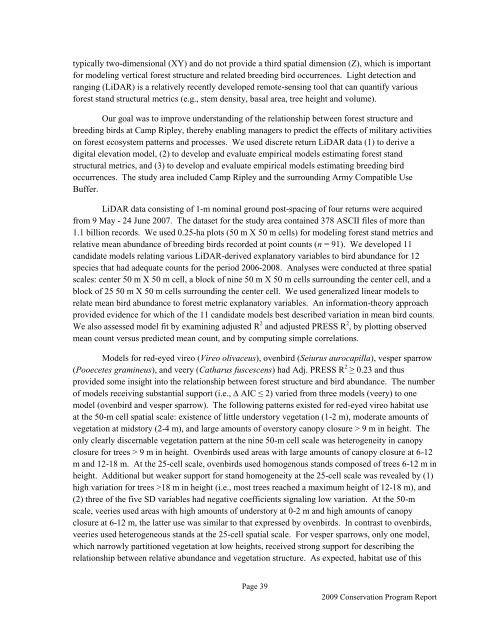camp ripley and arden hills minnesota army national guard training ...
camp ripley and arden hills minnesota army national guard training ...
camp ripley and arden hills minnesota army national guard training ...
Create successful ePaper yourself
Turn your PDF publications into a flip-book with our unique Google optimized e-Paper software.
typically two-dimensional (XY) <strong>and</strong> do not provide a third spatial dimension (Z), which is important<br />
for modeling vertical forest structure <strong>and</strong> related breeding bird occurrences. Light detection <strong>and</strong><br />
ranging (LiDAR) is a relatively recently developed remote-sensing tool that can quantify various<br />
forest st<strong>and</strong> structural metrics (e.g., stem density, basal area, tree height <strong>and</strong> volume).<br />
Our goal was to improve underst<strong>and</strong>ing of the relationship between forest structure <strong>and</strong><br />
breeding birds at Camp Ripley, thereby enabling managers to predict the effects of military activities<br />
on forest ecosystem patterns <strong>and</strong> processes. We used discrete return LiDAR data (1) to derive a<br />
digital elevation model, (2) to develop <strong>and</strong> evaluate empirical models estimating forest st<strong>and</strong><br />
structural metrics, <strong>and</strong> (3) to develop <strong>and</strong> evaluate empirical models estimating breeding bird<br />
occurrences. The study area included Camp Ripley <strong>and</strong> the surrounding Army Compatible Use<br />
Buffer.<br />
LiDAR data consisting of 1-m nominal ground post-spacing of four returns were acquired<br />
from 9 May - 24 June 2007. The dataset for the study area contained 378 ASCII files of more than<br />
1.1 billion records. We used 0.25-ha plots (50 m X 50 m cells) for modeling forest st<strong>and</strong> metrics <strong>and</strong><br />
relative mean abundance of breeding birds recorded at point counts (n = 91). We developed 11<br />
c<strong>and</strong>idate models relating various LiDAR-derived explanatory variables to bird abundance for 12<br />
species that had adequate counts for the period 2006-2008. Analyses were conducted at three spatial<br />
scales: center 50 m X 50 m cell, a block of nine 50 m X 50 m cells surrounding the center cell, <strong>and</strong> a<br />
block of 25 50 m X 50 m cells surrounding the center cell. We used generalized linear models to<br />
relate mean bird abundance to forest metric explanatory variables. An information-theory approach<br />
provided evidence for which of the 11 c<strong>and</strong>idate models best described variation in mean bird counts.<br />
We also assessed model fit by examining adjusted R 2 <strong>and</strong> adjusted PRESS R 2 , by plotting observed<br />
mean count versus predicted mean count, <strong>and</strong> by computing simple correlations.<br />
Models for red-eyed vireo (Vireo olivaceus), ovenbird (Seiurus aurocapilla), vesper sparrow<br />
(Pooecetes gramineus), <strong>and</strong> veery (Catharus fuscescens) had Adj. PRESS R 2 ≥ 0.23 <strong>and</strong> thus<br />
provided some insight into the relationship between forest structure <strong>and</strong> bird abundance. The number<br />
of models receiving substantial support (i.e., ∆ AIC ≤ 2) varied from three models (veery) to one<br />
model (ovenbird <strong>and</strong> vesper sparrow). The following patterns existed for red-eyed vireo habitat use<br />
at the 50-m cell spatial scale: existence of little understory vegetation (1-2 m), moderate amounts of<br />
vegetation at midstory (2-4 m), <strong>and</strong> large amounts of overstory canopy closure > 9 m in height. The<br />
only clearly discernable vegetation pattern at the nine 50-m cell scale was heterogeneity in canopy<br />
closure for trees > 9 m in height. Ovenbirds used areas with large amounts of canopy closure at 6-12<br />
m <strong>and</strong> 12-18 m. At the 25-cell scale, ovenbirds used homogenous st<strong>and</strong>s composed of trees 6-12 m in<br />
height. Additional but weaker support for st<strong>and</strong> homogeneity at the 25-cell scale was revealed by (1)<br />
high variation for trees >18 m in height (i.e., most trees reached a maximum height of 12-18 m), <strong>and</strong><br />
(2) three of the five SD variables had negative coefficients signaling low variation. At the 50-m<br />
scale, veeries used areas with high amounts of understory at 0-2 m <strong>and</strong> high amounts of canopy<br />
closure at 6-12 m, the latter use was similar to that expressed by ovenbirds. In contrast to ovenbirds,<br />
veeries used heterogeneous st<strong>and</strong>s at the 25-cell spatial scale. For vesper sparrows, only one model,<br />
which narrowly partitioned vegetation at low heights, received strong support for describing the<br />
relationship between relative abundance <strong>and</strong> vegetation structure. As expected, habitat use of this<br />
Page 39<br />
2009 Conservation Program Report
















